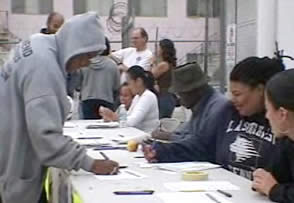 |
 |
 You’re probably getting sick of us saying it, but here we go again: voter registration alone is not enough. As Henry Serrano explains in the video, a voter is much more likely to vote when they have had a conversation with a canvasser.This is the ID part and it's crucial, because that’s where the voter learns something about what's at stake in the election and canvassers and phone-bankers in turn learn something about the issues that matter most to the voter, as well as when field organizers solicit donations of time or money, gauge the need for further contact, and offer assistance on Election Day.
You’re probably getting sick of us saying it, but here we go again: voter registration alone is not enough. As Henry Serrano explains in the video, a voter is much more likely to vote when they have had a conversation with a canvasser.This is the ID part and it's crucial, because that’s where the voter learns something about what's at stake in the election and canvassers and phone-bankers in turn learn something about the issues that matter most to the voter, as well as when field organizers solicit donations of time or money, gauge the need for further contact, and offer assistance on Election Day.
That said – don’t neglect the registration part, especially in states that require that voters register before Election Day in order to be allowed to vote. Many people show up at the polls only to realize they’re not on the rolls, and it brings turnout rates down (in 2004, states that allow election day registration had a 69% turnout rate, compared to 52% in ones that don’t). Tracking down the registration form, filling it out properly and sending in to the right place are tasks that people tend to overlook when the election’s still weeks away, so giving your membership and community an opportunity to get that done without much hassle is important. It just shouldn’t the primary focus of your voter engagement work.
In an initiative campaign, the goals of voter ID work may include some combination of the following:
In nonpartisan electoral work, the goals of voter ID work may include some combination of the following: